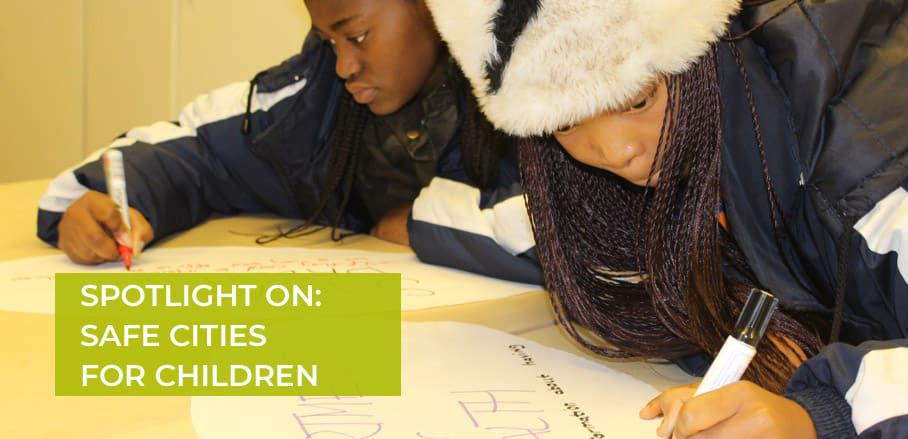Safer Cities for Children
Rapid and unplanned urbanization has many negative consequences, especially for children and young people. Many children live in urban areas without safe spaces to play, learn, and develop. The rights of children living in cities — including the right to health, the right to education, and the right of protection against violence — are violated, often on a daily basis. City leaders and planners must pay more attention to the needs and rights of urban children, especially those exposed to violence.
In 2017, the German NGO Kindernothilfe launched a campaign to raise awareness of children’s right to live free from the threat of violence and crime. The future of violence is urban: most deaths occur in urban settings, and without intervention this trend will accelerate. Young children are extremely vulnerable to violence, and high rates of violence against children indicate that an urban area is not safe enough. [inlinetweet prefix=”” tweeter=”urbanet_info” suffix=””]Providing safe spaces for children improves safety for all urban residents.[/inlinetweet]
Urban planning and governance is key to insuring inclusive prosperity, safety, and well-being for all who live in cities, which is recognized in a number of UN initiatives. Agenda 2030’s Sustainable Development Goals include goals on cities and peace and security. UN Habitat III’s “Safer Cities Programme” includes a structured dialogue on crime prevention and urban safety. The UN’s New Urban Agenda agrees to promote safe, inclusive, accessible, green, and quality public spaces; and to enable all to live, work, and participate in urban life without fear of violence and intimidation, especially vulnerable populations like children and youth. Urban safety is also a part of the upcoming World Urban Forum in Kuala Lumpur.
But despite the focus on urban safety, violence against children in cities does not play a central role in these dialogues. To increase attention to the need to make cities safer for children, in 2017 Kindernothilfe launched its campaign “Life in the city is no child’s play” in Germany and worldwide. The campaign conducts dialogues with Kindernothilfe’s urban partners and leads awareness-raising activities, including workshops and conferences for children and youth. The diverse campaign incorporates creative elements like hopscotch games and quizzes; political advocacy, including a public petition; and research on best practices for children’s safety.
Best Practices: Youth for Christ in Durban, South Africa
Currently, Kindernothilfe is collecting best practices from its partners and other interested stakeholders for its study of the most successful initiatives creating safer spaces to play, learn, and develop. One of its partners, the South African NGO Youth for Christ (YFC), seeks to improve safety by working with children and youth in Durban’s most vulnerable communities.
[inlinetweet prefix=”” tweeter=”urbanet_info” suffix=””]Violent crime in South Africa is disproportionately concentrated in the urban areas and in the most marginalized communities[/inlinetweet], where rates of youth unemployment, poverty, inequality, social exclusion, and drug abuse are high. The apartheid system’s legacy of inequality is apparent in the townships’ fragmented family structures and lack of adequate housing, infrastructure, and social services. Mismanaged housing and urbanization policies have reduced the quality of life of many communities. The fear of violence and crime in urban settings blocks economic and social development for residents, especially women and girls.
Efforts to prevent violence must be planned and implemented with stakeholders, including the most vulnerable and marginalized in the community. YFC conducts peer-to-peer workshops and camps to inspire its youth change agents to be responsible for their community and convince others to live free of violence. All stakeholders—from the most vulnerable, like girls, orphans, and people with disabilities, to youth gangs and political decision-makers—participate in stakeholder dialogue meetings and activities moderated by community members and facilitated by YFC.
The change agents’ peer-to-peer work uses a community-based, coalition-orientated, multi-sectoral and evidence-based approach that has proven effective for building community. To date, YFC’s efforts have been successful: youth in the participating communities have progressed from frustration and violence, to advocating with decision-makers and playing an active role in making their community a safer place for all to live. Long-term success in the townships can only be achieved by advocating for positive change and convincing all stakeholders to participate.
Recommendations for Safer Cities
- Create safe places for children: Urban planning must be child-friendly and future-oriented so that children can safely play, learn, and develop.
- Meaningful participation is key: Map safe and unsafe places and identify risks of violence and abuse through a participatory assessment process that actively and meaningfully involves the community, especially its children and youth.
- Improve child protection systems: Implement municipal-level regulations and pursue legal persecution of all kinds of violence against children.
Going forward, [inlinetweet prefix=”” tweeter=”urbanet_info” suffix=””]Kindernothilfe will support the implementation of the New Urban Agenda’s call for inclusive measures to protect urban safety, prevent crime and violence[/inlinetweet], and engage relevant local communities—and all with a focus on children. In 2018, Kindernothlife will publish the results of its best practices study and will share its lessons through a dialogue process with implementing NGOs, communities, and urban planners and government decision-makers from the municipal to national levels.
For more on the campaign, see www.kindernothilfe.org/nochildsplay
- Safer Cities for Children - 15. February 2018
